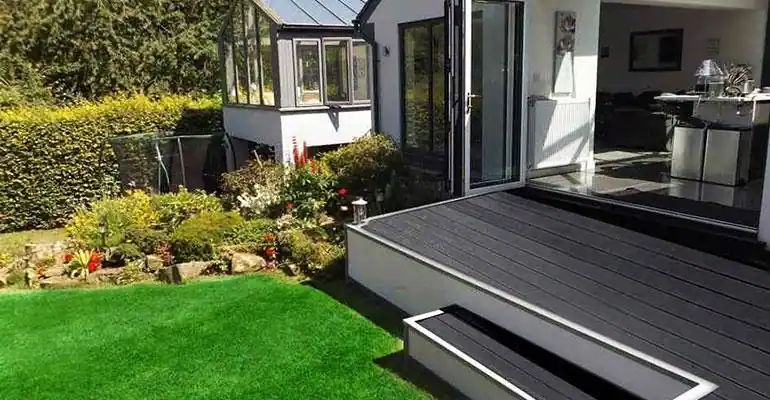Choose the material for your deck. This is one of the most important choices you have to make when planning it. Most people choose wood or wood-plastic composites as an option. By comparing the pros and cons of wood and composite decking, we can help you choose the best material for your deck, whether you want to do it yourself or hire an expert.
In an Angi blog post, contractor Tim Slamans says, “The first thing you should know about picking a deck material is that most decks use treated lumber for the framing. This is the part of the deck that you don’t usually see unless you look under it.” So, the process of making a choice usually only involves the materials that make up the decking surface and railings.
Choices for Wood Decking
An extremely large range of wood types can be used for decks and balustrades. There are a lot of cedar, oak, and pressure-treated pine lumberyards in the United States. Tigerwood, ipe (pronounced “EE-pay”), and mahogany are all tropical hardwood decking choices that people who like unique wood species may like.
What Does Composite Decking Consist Of?
Some people also call these boards “composite wood decking” or wood-plastic composite decking. They were created in the late 1980s. They are made of wood fibers that are wrapped in plastic. Composite decking can be bought at big box home improvement stores like The Home Depot and Lowe’s, as well as at local lumberyards all over the United States.
As people and builders learn more about the problems with wood decking, a lot of them are switching to high-performance composite decking.
What are the pros and cons of wood and composite decking?
Wood decking is popular with many homeowners because it is easy to find, doesn’t cost much, and looks good. Decks made of wood have problems like rotting, splinters, and needing a lot of upkeep. Even though composite wood might be easier to take care of than real wood, some people worry that it won’t look as nice. But as manufacturing has improved, composites have been made that look like real, expensive wood without the upkeep problems that come with wood decks.
When deciding between wood and composite decks, these things should be thought about:
Which One Looks Better?
In its early versions, composite decks looked fake and plastic-like. But some modern composites have a random embossed grain pattern and a varied look to make sure that no two boards are the same.
Which Is Better at Refusing Water?
One big problem with wooden decks is that the boards easily soak up water. If you don’t stain, seal, and paint your wood decks regularly, they will eventually go bad and warp, splinter, split, and disappear.
Which one needs the least upkeep?
To keep wooden decking safe from damage caused by water, weather, and insects, it needs to be sealed, stained, and painted on a regular basis. How often do I need to paint, stain, and seal my wood deck? Never, ever, ever! Composite decking planks only need to be swept or washed to keep their strength and good looks.
What Can’t Be Hurt by Bugs?
Pests like bugs and rodents can get into wooden decks. Normal painting and coating can slow down the damage, but they can’t stop it completely. Termites and other insects that eat wood can’t get into composite decks because it doesn’t need to be painted or sealed.
What Takes Away Stains?
All types of wood decking will get splinters over time, especially if it is subject to changes in temperature and moisture. Composed of small wood strands encased in plastic, composite decking doesn’t splinter even when exposed to changes in the weather. This is especially important for kids’ and pets’ sensitive feet and places where a lot of people walk barefoot, like pool decks.
What is the difference in cost?
When people choose between wood and composite decks, price is the main thing they think about. Among the pros and cons of wood decks, the fact that it is affordable is definitely a pro. Most of the time, wood decking is cheaper than composite decking, especially when you think about the original cost.
Still, even though wood is cheaper at first, composite decking usually pays for itself in two to three years, when you add up the cost of upkeep each year. The price difference is also affected by the state of the local market and the type of wood chosen instead of the brand of composite decks.
Which one is best for work?
Both wood and plastics are easy to cut and join with tools you already have at home. One good thing about composite decking is that it is easier to shape into curved deck parts by heating it.
Which gives you a cooler surface temperature?
There are different effects of heat and cold on wood and composite decks. Composite decking can get too hot in direct sunlight, while wood decking usually performs better in the summer. This is because composites are more dense and can melt.
In the end, your deck will be more comfy on hot days. In fact, blisters can start to form on the feet in temperatures as low as 109 degrees Fahrenheit. This difference of 35% can be especially noticeable in the middle of summer.
Choosing Which One to Make
To cut down the huge selection, it helps to first decide which type of wood decking you like best, then compare that to the type of composite decking you like best. So, it’s easier for you to make your choice between treated lumber and composite, cedar and composite, or redwood and composite. This gets rid of the need to look at dozens of options side by side.



